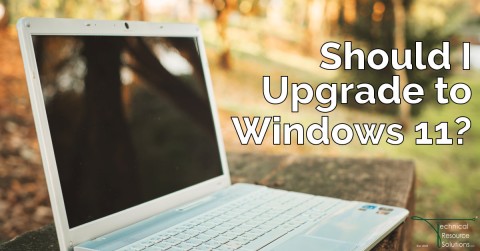Windows 11 Rolls Out Today!
In 2015, Microsoft said that Windows 10 would be the last versioned release of the operating system. So it came as a surprise to many when the company announced the upcoming release of Windows 11 earlier this year. If you're not inclined to keep up with the latest technology, this may come as a bit of a surprise, and you may be wondering how such an upgrade will affect the IT infrastructure of your business. The tech news world has been aflutter with information and speculation as to the nature of the Windows 11 update, but now that there are more concrete facts, here's what you need to know:
What's New in Windows 11?
According to Microsoft, "Windows 11 is designed to support today's hybrid work environment, and intended to be the most reliable, secure, connected, and performant Windows operating system ever." It seems that Windows 11 will aim to be compatible with all the tools and apps you're used to using on Windows 10, while adding additional features to help you be more productive in the day-to-day.
Since March 2020, many of us saw technology's role of our lives change drastically: personal and workspaces collided, and Microsoft kept that knowledge at the forefront of their Windows 11 redesign. One way they do this is by improving the ability to create separate desktops for each area of your life whether it be personal, work, school, or gaming. One of the single most noticeable design changes will be the location of Start, which will be at the center of the taskbar at the bottom of your screen.
A few of the other features Microsoft has teased with Windows 11 include:
- Partnership with Amazon to bring some Android apps to Windows
- Increased security
- Faster system
- Redesign for increased productivity
- Updates to Microsoft Teams
- New desktop widgets
- Snap Groups and Snap Layouts, to make transitioning from a laptop dock to a mobile laptop experience a smoother experience
- Improved Xbox integration for the PC gamers among us
What are Reported Downsides of Windows 11?
For some, the new look of Windows 11 might come as a bit jarring, potentially bringing back unpleasant memories of interfaces past (like Windows 8). Taskbar content is now centered on the screen, and the taskbar itself is now stuck fast to the bottom of the screen – no options to move the taskbar to the sides or top of the screen exist in Windows 11.
Additionally, the Windows 10 "tablet mode" intended for convertible laptops is gone, replaced with more iPad like controls for navigating your Windows 11 environment with touch. That said, this change comes with a variety of added benefits that may make touchscreen Windows 11 browsing easier, such as touch gestures.
It might not be as easy for users with older machines to upgrade to Windows 11, as system requirements include things like a graphics card that supports DirectX 12 and a high-definition display. If you bought your computer before 2015, there's a chance the graphics chip doesn't support the latest technology required by Windows 11.
Where Do I Get Windows 11?
For home computers, Windows 11 is expected to begin rolling out to devices during the holiday season, so long as your computer is using an active license of Windows 10 and the computer meets Microsoft's system requirements for the new operating system. It's said that you'll get the opportunity to opt-in to the update, or to sit this one out for now. There is no obligation to move forward with the update. Additionally, it has also been said that users who choose to upgrade will have 10 days to switch back to Windows 10 if they decide Windows 11 is not for them.
Should I Update to Windows 11?
If you're thinking about updating your home computer after taking a look at the many pros and cons of the Windows 11 upgrade, keep that ten-day reversion period in mind. You have time to revert your operating system back to Windows 10 if you don't like what you see! That said, it's imperative before making any operating system changes that you back up your files first. If you choose not to update to Windows 11, keep in mind that Microsoft has committed to supporting Windows 10 through 2025, so you will still be receiving security updates.
Whether you're skeptical or excited about the Windows 11 update, you may want to think twice before making any changes to your computer. Much like any large update, we recommend opting out of the update for the initial release. Allow some time for the program to be tested by the general public and receive bug fixes before installing on your own system. Your computer will run just as efficiently (and depending on age - perhaps more efficiently) on Windows 10, preventing disruption to your company's workflow.
If you're a business owner, an IT team is crucial in many cases, but especially when there is a major Operating System update hitting the market. The Technical Resource Solutions team will be testing Windows 11 internally upon its public release and even prior to that on internal test systems and providing our clients with an upgrade recommendation based on each client's specific needs. This prevents a knee-jerk update that could have negative effects in the workplace.
If you have any further questions about the Windows 11 update, please feel free to open a ticket with us!
Submit a Support Ticket
If you utilize the Technical Resource Solutions Ticketing Portal to manage and create tickets, click the button below to open a new support ticket.
Ticketing PortalIf you do not currently have access to the ticketing portal, give us a call to request access.
Call TechnicalRS





